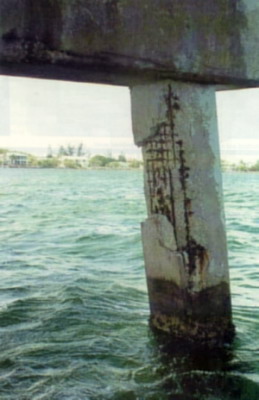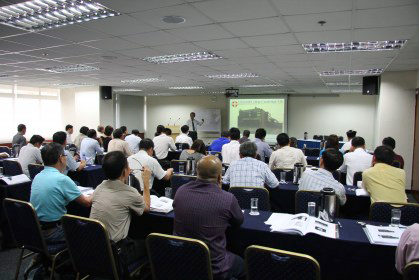|
Home | Consulting | Training | Expert Witness | Failure Analysis | Design Review | Corrosion Test | Corrosion Software | Protective Coatings | Materials Selection | Cathodic Protection | >>> | ||
|
Course Outline |Who Should Attend |Registration |In-House |On-Demand |Online Courses |PPT Slides+Testbank |Course List | Why WebCorr |
||
|
Course Overview |
||
|
This corrosion short course can be taken as in-house training course, online course and distance learning course worldwide. It can also be customized to meet the specific needs of your organization.
|
||
|
||
| Course Outline | ||
|
1.
Corrosion and concrete durability
2. Terminology and conventions
3. Why & How does rebar corrode in concrete? 3.1
corrosion of steel in aqueous environment
4. How to control and prevent concrete
corrosion
5. Surveying and diagnosing
6. Testing and Monitoring
7. Repair and
Rehabilitation
8. Corrosion Modeling and Prediction Software 8.1 Concrete-Compass: Corrosion Modeling and Life Prediction of Reinforced Concrete Structures 8.2 CP-Compass-Concrete: Design Calculations for Cathodic Protection of Reinforced Concrete Structures
|
||
|
Course Outline |Who Should Attend |Registration |In-House |On-Demand |Online Courses |PPT Slides+Testbank |Course List |
||
| Who Should Attend This Corrosion Course | ||
Successful completion of this corrosion course helps participants prepare for their NACE certification examinations at the Corrosion Technician, Corrosion Technologist and Senior Corrosion Technologist levels. |
||
| Registration for This Corrosion Course | ||
|
|
||
| In-House Training Corrosion Courses | ||
|
There is no limit to the number of participants required for in-house training corrosion courses or on-site training corrosion courses. We conduct the in-house or on-site training corrosion courses at your company's premises worldwide and at a time convenient to your company. Click here to contact us for a quotation. |
||
| Corrosion Course-On-Demand | ||
|
All our publicly scheduled corrosion short courses are conducted once a year. However, you do not need to wait for one year if you have missed any of the publicly scheduled corrosion courses as we have this unique corrosion course-on-demand scheme: we will conduct the course just for you on an one-on-one basis at a time and in a location convenient to you. This option costs significantly less than a full-scale in-house training program. Click here to contact us for a quotation for taking this course as course-on-demand. |
||
| Online and Distance Learning Corrosion Courses | ||
|
Click here to register this corrosion short course for online or distance learning. |
||
| Corrosion Course-On-Webex | ||
|
Click here to contact us for a quotation. |
||
| PowerPoint Slides and Test Banks for Trainers, Instructors, Tutors, University Lecturers and Professors | ||
|
If you are involved in teaching or training, you may wish to purchase a complete set of the trainer's package for this training course. The trainer's package comes complete with ready-to-use PowerPoint slides (fully editable) and test bank (with answer keys). These ready-to-use PowerPoint slides contain high quality color photographs, illustrations, animations, audio and video clips. The test bank contains questions conveniently grouped into four categories: (1) true or false, (2) multiple choice, (3) calculation, and (4) reasoning and open-ended discussions. The trainer's package is suitable for in-house training and university teaching (30 lecture hours). This is exactly the same package that WebCorr uses to deliver our current training course. The one-time lump sum fee allows your organization to use the training package and also modify it. For example, your organization may modify the course contents and re-name/re-brand the course under your organizationís name. WebCorr only retains the copyright of the original PowerPoint slides and test banks.
Click here to contact us if you need more information on the trainer's package. |
||
|
Course Outline |Who Should Attend |Registration |In-House |On-Demand |Online Courses |PPT Slides+Testbank |Course List |
||
|
Copyright © 1995-2024. All rights reserved. |
||
 The corrosion of reinforcing steel in concrete structures such as
buildings, car parks, concrete marine structures, road beds, bridge
decks and bridge substructures is a world-wide problem and leads to
cracking, staining, spalling from the surface and ultimately structural
weakness. This 5-day advanced course thoroughly and systematically covers the
concrete durability issues: the causes of reinforcement corrosion,
common control and prevention methods for both old and new structures,
surveying and diagnosing techniques for condition assessment, the
conventional and some promising emerging technologies for repair and
rehabilitation of concrete structures. Participants will gain essential
knowledge and skills in managing corrosion in concrete structures.
Engineers, architects and designers will grasp the theories and
practices of corrosion control and prevention which would lead to
corrosion-proof designs and low cost durability. Participants will also
learn the principles and applications of advanced corrosion sensors and
monitoring systems for life prediction, repair and rehabilitation,
surveying, diagnosis and condition assessment. Facility owners will
benefit from increased durability, enhanced safety and reduced
maintenance costs.
The corrosion of reinforcing steel in concrete structures such as
buildings, car parks, concrete marine structures, road beds, bridge
decks and bridge substructures is a world-wide problem and leads to
cracking, staining, spalling from the surface and ultimately structural
weakness. This 5-day advanced course thoroughly and systematically covers the
concrete durability issues: the causes of reinforcement corrosion,
common control and prevention methods for both old and new structures,
surveying and diagnosing techniques for condition assessment, the
conventional and some promising emerging technologies for repair and
rehabilitation of concrete structures. Participants will gain essential
knowledge and skills in managing corrosion in concrete structures.
Engineers, architects and designers will grasp the theories and
practices of corrosion control and prevention which would lead to
corrosion-proof designs and low cost durability. Participants will also
learn the principles and applications of advanced corrosion sensors and
monitoring systems for life prediction, repair and rehabilitation,
surveying, diagnosis and condition assessment. Facility owners will
benefit from increased durability, enhanced safety and reduced
maintenance costs. If you are concerned with corrosion in your
business, in-house training or on-site training is a great solution to train a group of
employees from design, production, operation, quality assurance, inspection
and maintenance, and technical sales and support on corrosion control and
corrosion prevention technology. The contents of all our corrosion courses can
be customized to fit your organization's needs.
If you are concerned with corrosion in your
business, in-house training or on-site training is a great solution to train a group of
employees from design, production, operation, quality assurance, inspection
and maintenance, and technical sales and support on corrosion control and
corrosion prevention technology. The contents of all our corrosion courses can
be customized to fit your organization's needs.

 All our corrosion short courses are available for online or offline
distance learning. You can start an online course at any time and learn
at your own comfortable pace, whenever and wherever you are. You have
around-the-clock access to interactive and media-rich course materials,
virtual labs, course instructions, course assignments, and course
assessments. Discussions and questions related to the corrosion courses
are posted on the website or exchanged through email for a period up to
12 months. Video conferencing or instant messaging can also be arranged
for discussions of course topics. For those who do not have ready access
to internet, we can send you our online course materials on a CD-ROM or
DVD or USB memory stick for offline learning.
All our corrosion short courses are available for online or offline
distance learning. You can start an online course at any time and learn
at your own comfortable pace, whenever and wherever you are. You have
around-the-clock access to interactive and media-rich course materials,
virtual labs, course instructions, course assignments, and course
assessments. Discussions and questions related to the corrosion courses
are posted on the website or exchanged through email for a period up to
12 months. Video conferencing or instant messaging can also be arranged
for discussions of course topics. For those who do not have ready access
to internet, we can send you our online course materials on a CD-ROM or
DVD or USB memory stick for offline learning. Webex
is hosted by Cisco, a product purpose-built for real-time web
communications. If you are an existing user of Webex, or if you are
willing to experience the power of Webex, we can conduct the course for you
over Webex with audio and video presentations and interactions with the
course instructor and other course attendees in real-time. It is just
like the physical classroom settings that everyone can interact with each
other. Your questions will be answered in real time by our instructor.
Webex
is hosted by Cisco, a product purpose-built for real-time web
communications. If you are an existing user of Webex, or if you are
willing to experience the power of Webex, we can conduct the course for you
over Webex with audio and video presentations and interactions with the
course instructor and other course attendees in real-time. It is just
like the physical classroom settings that everyone can interact with each
other. Your questions will be answered in real time by our instructor.